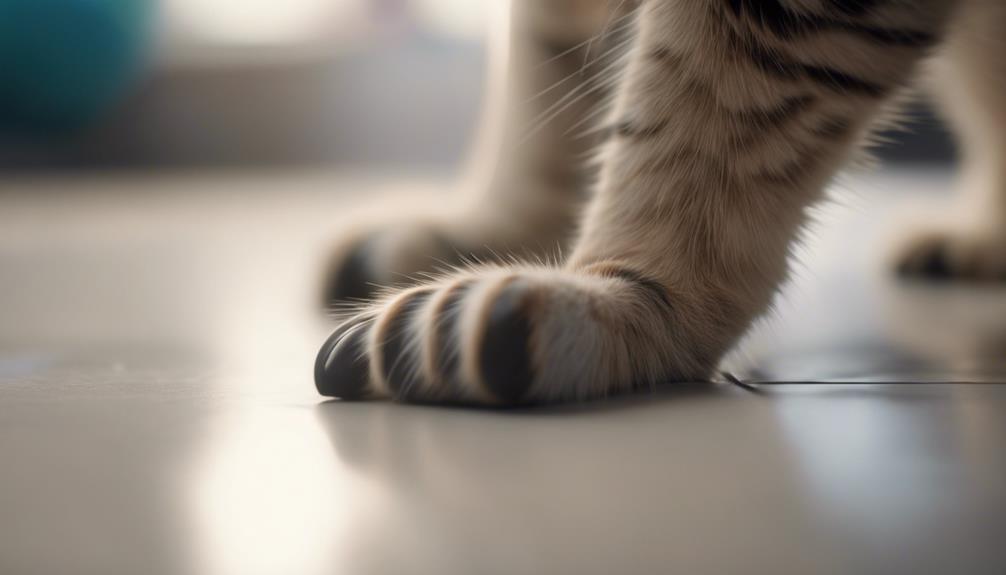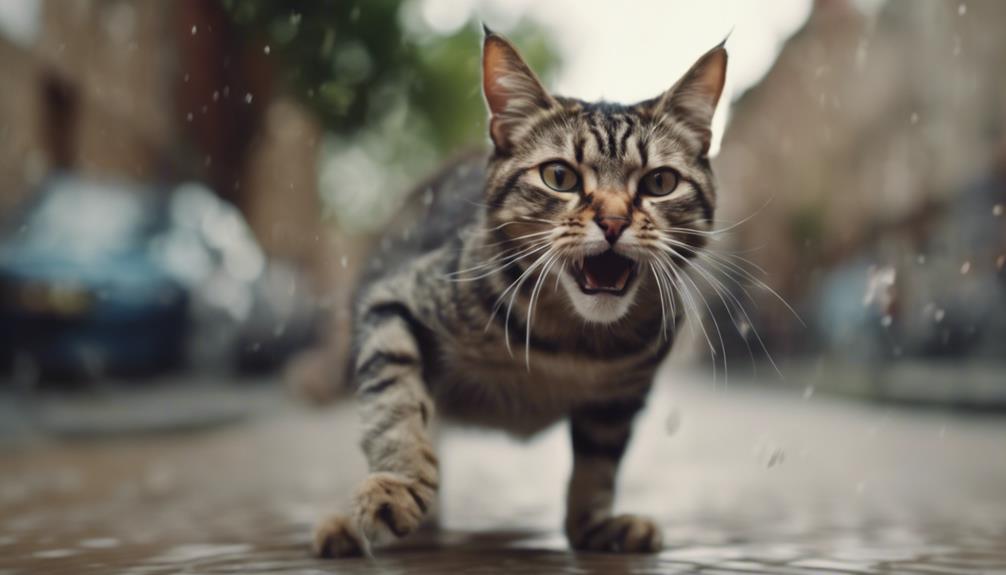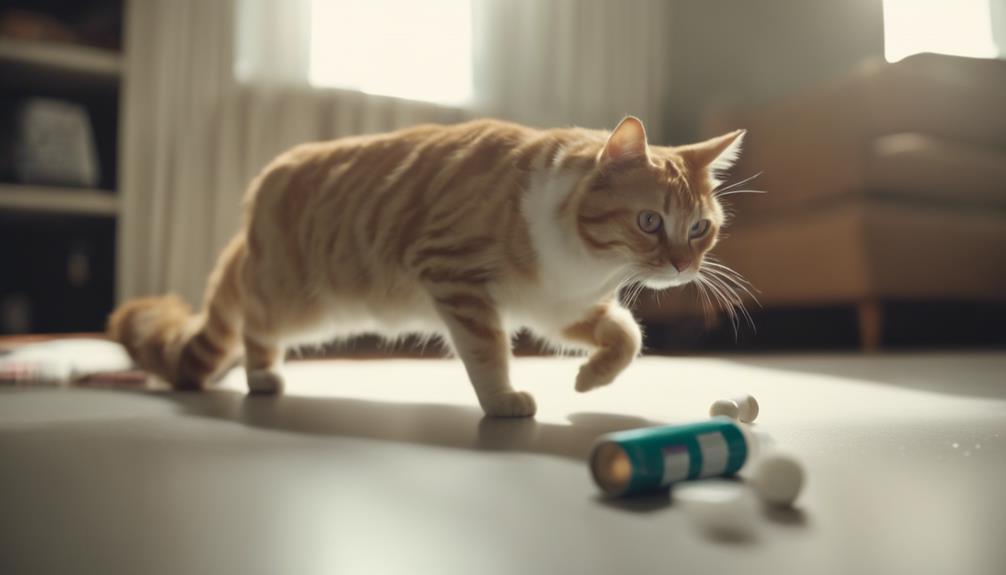Feline arthritis is a condition that can often go unnoticed, masking itself behind what may seem like typical feline behavior. Cats are known for their agility and grace, but as they age, signs of arthritis can subtly creep in.
Recognizing these signs is crucial for early intervention and ensuring your feline companion's comfort. By understanding the key indicators and taking proactive steps, you can make a significant difference in your cat's quality of life.
Key Takeaways
- Recognize signs of feline osteoarthritis early for prompt diagnosis and management.
- Use a free online checklist and video evidence to assist in screening and diagnosis.
- Treatment focuses on comfort, pain control, weight management, and environmental modifications.
- Regular monitoring and communication with your vet are essential for your cat's joint health.
Understanding Feline Osteoarthritis
What factors contribute to the development of feline osteoarthritis, a degenerative joint disease prevalent in aging cats?
Feline osteoarthritis arises from various factors, including injuries, abnormal joint shapes, and the natural process of wear-and-tear on joints over time.
As cats age, the prevalence of osteoarthritis increases significantly, with studies showing that 61% of cats aged six years and older exhibit X-ray evidence of the condition in at least one joint.
Additionally, nearly half of older cats experience osteoarthritis in multiple joints. Understanding these contributing factors is crucial in recognizing and addressing feline osteoarthritis to ensure the best possible quality of life for aging cats.
Commonly Affected Joints in Cats
Feline osteoarthritis commonly affects joints such as the spine, hip, knee, ankle, and elbow in aging cats. The progression of osteoarthritis in these joints can lead to pain, stiffness, and reduced mobility in affected cats.
Here are some commonly affected joints in cats:
- Spine: Osteoarthritis in the spine can result in decreased flexibility and discomfort during movement.
- Hip: Affected hip joints may cause limping, reluctance to jump, or difficulty in getting up.
- Knee: Osteoarthritis in the knee joint can lead to lameness and visible swelling.
- Elbow: Cats with elbow osteoarthritis may exhibit lameness, favoring one leg over the other.
Factors Contributing to Osteoarthritis

Various factors contribute to the development of osteoarthritis in cats. Injuries, such as fractures or ligament tears, can damage cartilage within joints, leading to arthritis over time. Abnormal joint shapes, often due to genetic predispositions or developmental issues, can cause uneven pressure distribution within the joint, accelerating cartilage degeneration. Additionally, the normal wear-and-tear that joints experience as cats age can gradually wear down protective cartilage, eventually resulting in osteoarthritis.
Understanding these contributing factors can help cat owners and veterinarians take proactive steps to manage and mitigate the effects of osteoarthritis in feline companions.
Prevalence and Age-Related Statistics
In understanding the impact of osteoarthritis on cats, it is essential to consider the prevalence of this degenerative joint disease and its correlation with age-related statistics.
- 61% of cats aged six years and older show X-ray evidence of osteoarthritis in at least one joint.
- 48% of older cats have osteoarthritis in multiple joints.
- The prevalence of osteoarthritis increases with age in felines.
- Cats are more likely to develop osteoarthritis as they grow older, especially past the age of six.
Recognizing Signs in Cats

Early detection of osteoarthritis in cats can be facilitated by recognizing subtle signs that may indicate joint degeneration. These signs include difficulty in jumping, using stairs, running, and chasing objects. Cats with osteoarthritis may also exhibit inappropriate elimination, decreased energy levels, and increased irritability.
Since behavioral changes can be subtle and mistaken for normal aging, it is essential for cat owners to pay close attention to these signs. Observing and noting these changes early on can help in initiating timely interventions to manage the condition effectively.
Screening and Diagnosis Methods
To effectively determine the presence of osteoarthritis in cats, utilizing screening and diagnostic methods is crucial for early intervention and proper management of the condition.
- Online Checklist: Use a free online tool to screen for osteoarthritis signs in cats.
- Video Documentation: Record your cat's movements for vet assessment.
- Physical Examination: Combine video evidence with a thorough physical exam.
- X-ray Imaging: X-rays can provide detailed information on joint health for a conclusive diagnosis.
Treatment and Management Approaches

Improving comfort and slowing disease progression are key objectives in the treatment and management of feline osteoarthritis. Pain control is essential for enhancing exercise willingness and managing weight. Weight control plays a significant role in reducing stress on joints, with prescription diets and nutritional supplements aiding in joint health support. Environmental modifications, such as ramps and steps, can facilitate comfortable movement for cats affected by osteoarthritis.
| Treatment Approach | Description | Benefits |
|---|---|---|
| Pain Control | Crucial for improving exercise willingness and weight management. | Enhances comfort and mobility. |
| Weight Control | Reduces stress on joints; prescription diets and nutritional supplements support joint health. | Helps manage arthritis symptoms and improve overall health. |
| Environmental Modifications | Utilizing ramps and steps can aid in comfortable movement for cats with osteoarthritis. | Facilitates easier navigation and reduces strain on affected joints. |
Frequently Asked Questions
Can Indoor Cats Also Develop Osteoarthritis or Is It More Common in Outdoor Cats?
Indoor cats can develop osteoarthritis, with age being a significant risk factor. This condition is not exclusive to outdoor cats. Factors like genetics, previous injuries, and weight can contribute to the development of osteoarthritis in indoor felines.
Are There Any Specific Breeds of Cats That Are More Prone to Developing Osteoarthritis?
Certain cat breeds, such as Maine Coons and Persians, are predisposed to developing osteoarthritis due to genetic factors. However, any cat, regardless of breed, can develop this condition. Regular monitoring and early intervention are key in managing osteoarthritis in felines.
Can Weather or Climate Affect the Symptoms of Osteoarthritis in Cats?
Weather or climate can potentially impact the symptoms of osteoarthritis in cats. Cold, damp conditions might exacerbate joint pain and stiffness, while warm, dry climates could offer some relief. Environmental factors should be considered when managing feline osteoarthritis.
Are There Any Alternative or Holistic Treatments for Feline Osteoarthritis That Can Be Effective?
While traditional veterinary treatments are common for feline osteoarthritis, some pet owners explore alternative and holistic approaches like acupuncture, chiropractic care, and herbal supplements. However, efficacy varies, and consultation with a veterinarian is advisable.
How Can a Cat Owner Differentiate Between Normal Age-Related Changes in Their Cat and Symptoms of Osteoarthritis?
Differentiating between normal aging changes and osteoarthritis symptoms in cats involves observing signs like decreased activity, reluctance to jump, and litter box issues. Consult a vet for a thorough evaluation and possible diagnostic tools to confirm osteoarthritis.
Can Fading Kitten Syndrome Symptoms Be Mistaken for Arthritis in Cats?
Yes, fading kitten syndrome symptoms can be mistaken for arthritis in cats. Both conditions can lead to stiffness, decreased mobility, and reluctance to move. It’s important to consult a veterinarian for proper diagnosis and treatment as mistaking one for the other can lead to serious consequences for the cat’s health.
Conclusion
In conclusion, recognizing the signs of arthritis in cats is crucial for their well-being. By understanding the common affected joints, contributing factors, and prevalence statistics, we can proactively manage this degenerative joint disease.
Through innovative screening and diagnostic methods, as well as holistic treatment approaches, we can alleviate discomfort and promote joint health in our feline companions. Increasing our awareness and knowledge on feline osteoarthritis empowers us to provide better care for our beloved cats.




